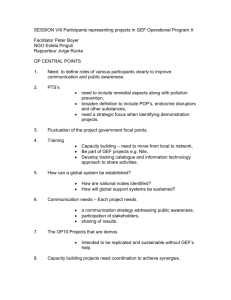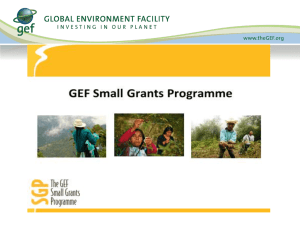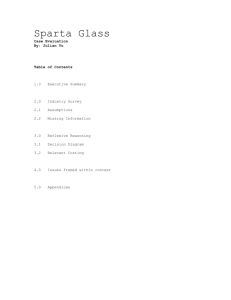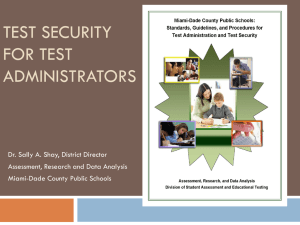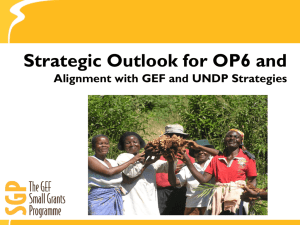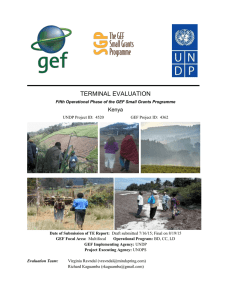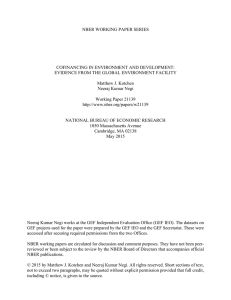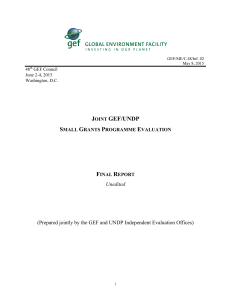English
advertisement
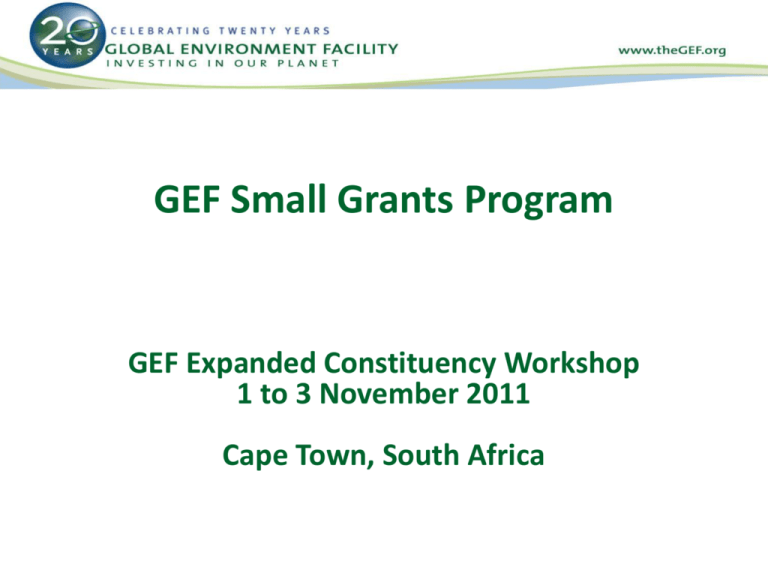
GEF Small Grants Program GEF Expanded Constituency Workshop 1 to 3 November 2011 Cape Town, South Africa Scope of GEF SGP? • The SGP supports community-level initiatives across the range of global environmental issues addressed by the GEF • SGP operationalizes the maxim “think globally, act locally” • The “public face” of the GEF. • The communities targeted by SGP are often the poorest and most vulnerable – Typically have low levels of capacity to adequately address global environmental problems How it works? • The SGP is implemented by UNDP; – Global level - managed by a Central Management Team (CPMT) – Country level - National Coordinator (NC) and one assistant • Projects approved only at national/subregional level by National Steering Committee • National Steering Committee composed of: – Representatives from civil society and community based organizations (always in majority) – Representatives from government (usually OFP or his/her delegate); – NC serves as secretariat for National Steering Committee • SGP provides small grants up to $50,000 USD to civil society and community based organizations • The program is funded by the GEF from its replenishment agreement – 140 million USD in GEF-5 – All countries could allocate certain STAR resources using framework adopted by the Council in 2009 Results achieved by GEF SGP • The program has been operational since 1992 • Through its first 18 years, SGP has supported: – 13,776 community-level projects – Over $300.3 million in funding – Leveraging over $414.2 million in cash and in-kind co-financing Results achieved by GEF SGP Basic Stats Number of Projects Total Amount in Grants Total Amount of Cash Cofinancing Total Amount of Kind Cofinancing Total Amount of Cofinancing Total Amounts Average Amounts 13502 $322,163,944 USD $23,860 USD $216,382,767 USD $16,026 USD $340,084,832 USD $25,188 USD $556,467,598 USD $41,214 USD Number of Projects Implemented Climate Change Adaptation 2% Persistent Organic Pollutants 2% Land Degradation 12% Multifocal Area 11% International Waters 5% Climate Change 17% Biodiversity 51% Number of Projects by Region 4500.00 4000.00 3500.00 3000.00 2500.00 2000.00 1500.00 1000.00 500.00 0.00 Africa Arab States Asia and the Pacific Europe and the CIS Latin America and the Caribbean Policy for GEF-5 • Category I: All SIDS and LDC country programmes and country programmes that have been in operation for fewer than 5 years. • Category II: All country programmes that have been in operation between 5 and 15 years; – – – – further subdivided into those in operation between 5 and 9 years; 9 and 12 years; 12 and 15 years; those in operation more than 15 years but with cumulative grants received of less than $6 million before GEF-5. • Category III: All country programmes that have been in operation for more than 15 years and have been able to access a cumulative total of more than $6 million in grants received before GEF-5. Financial Framework: Core resources Category I Amount in US$/year SIDS/LDCs 250,000 Sub-regional SIDS Programmes 500,000 First Year Country Programmes 150,000 2-5 Years Old Country Programmes 200,000 Category II Category IIa (5-9 years) 150,000 Category IIb (9-12 years) 100,000 Category IIc (12-15 years, and more than 15 years with accumulated grants amount lower than $6 million) 50,000 Financial Framework: STAR Resources For country programs in Category I and Category II: • Countries which have an indicative overall STAR country allocation of up to $15 million, a maximum cumulative amount total of $2.4 million, with an average of up to $600,000 per year can be allocated. • Countries which have an indicative overall STAR country allocation of more than $15 million will no longer be able to access the SGP’s core funding and will need to finance their projects from their STAR allocations. A maximum cumulative amount of up to $3.6 million, with an average up to $900,000 per year can be allocated. • A new country entering the SGP with an indicative STAR country allocation can program a matching amount of STAR funds. For the second year and thereafter, the country will follow the standard guidelines above. Thank you! Questions?
